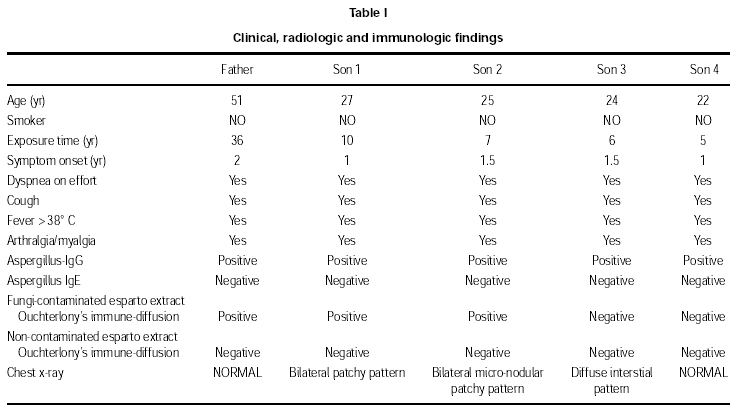INTRODUCTION
Esparto grass (Stipa tenacissima) is a gramineous plant widely found in the Mediterranean area. It has a wide variety of uses. The processing of esparto fibers includes the removal of blades from the plant, with posterior "soaking" in water pools for 15 to 20 days in order to make it resistant. During this process, the plant could be contaminated with some organisms because of the favorable moisture and temperature conditions. After that, the mass obtained is dried, crushed, and combed.
The first reports showing the esparto dust as a cause of respiratory disease appeared in the 1960s1. Recently, Aspergillus fumigatus has been reported as the etiologic agent of the hypersensitivity pneumonitis (HP) caused by esparto dust2. In this article, we report five patients of the same family (all of them plaster workers) who were seen with criteria consistent with HP caused by inhalation of dust derived from the esparto fibers used in their job.
CASES REPORT
We studied five patients of the same family who had respiratory and systemic symptoms related to their work environment. The patients had all come to the emergency department of our hospital at different times along last 2 years, and were then referred together, as outpatients, to our allergy department. The clinical and laboratory findings are shown in table I. All were men between the ages of 22 and 51 years. All five patients were plasterers and handled esparto fibers frequently. They worked together. The symptoms were developed after a period of 5 to 36 years of steady exposure to these fibers, and began 2 to 6 hours after subjects started to handle them. Initial symptoms consisted of cough and shortness of breath on effort. Later on, muscle and bone pain, malaise, fever, and dyspnea were associated. This above-mentioned symptoms were not presented every time they worked with esparto fibers; but they seemed to depend on the new batch of esparto fiber that the patients were predominantly handling in the last 2 years. The absence from work markedly decreased the severity of symptoms; however, they presented a variable degree of shortness of breath on effort even when on holiday. Chest roentgenograms showed a pathological pattern in 3 patients, it was normal in the other two. At the time of the study, patients were nearly free of symptoms because they had left their plasterer work for several weeks. They did not tell any symptom related to pollen or other allergens.
An esparto dust extract was made with several samples from the esparto fibers of the patients. These samples were crushed to obtain a thin dusty material. Two grams of this dusty material were diluted in 20 ml of phosphate-buffered saline (PBS). The solution was shaken for 24 hours and then passed through a 0.22 ttm Millipore filter (Millipore Corp., Bedford, Mass.) The samples of esparto grass provided by the patients were investigated to identify the presence of microorganisms. The cultures showed a luxuriant growth of Aspergillus fumigatus. We looked for and found other esparto fibers which was not contaminated with molds, and then we performed another extract by the same method.
Skin prick tests with theses extracts, and with a battery of common inhalants were performed. Skin prick testing was negative in father, son 1 and son 2. In sons 3 and 4 skin prick tests were positive to grass pollen. They did not tell any spring-related symptom.
Intradermal test with the fungi-contaminated esparto extract was positive at 6 hours in all patients. Intradermal test with the non-contaminated esparto extract was not positive in any patients. Intradermal tests with Aspergillus fumigatus extract was also positive at 6 hours, whereas no reaction was observed to other allergens. Grass pollen was not tested on intradermal testing in any patient.
Precipitating antibodies IgG to fungi and grass pollens were measured by fluoride-enzyme-immune-analysis (FEIA, CAP system, Pharmacia, Upsala, Sweden). Precipitating antibodies were detected in all patients against Aspergillus fumigatus, Aspergillus clavatus and Aspergillus ssp.
The double immunodiffusion Ouchterlony's technique showed precipitation bands between patients sera and fungi-contaminated esparto extract and Aspergillus spp, However, Ouchterlony's technique was negative for fresh stipa tenacissima and the non-contaminated esparto extract in all patients.
The members of family told to us that they understood the origin of their diseases; so that, they refused the possibility of a bronchoalveolar lavage (BAL) study and a pulmonary inhalation provocation test.
They decided to change their esparto fibers for a synthetic analog and symptoms did not appeared again.
DISCUSSION
An increasing number of organic and inorganic dusts have been able to cause hypersensitivity and disease in exposed subjects3 In our opinion, the cases reported here meet sufficient criteria to be considered as HP caused by the dust inhaled while handling fungi-contaminated esparto.
Previous reports have demonstrated that Aspergillus fumigatus is the etiologic agent of esparto dust induced HP2 During the esparto fiber manufacturing process, esparto grass is boiled in water pools in the soaking phase, resulting in a high degree of moisture. If it is then stored until the next manufacturing phase, the molds would have favorable moisture and temperature conditions for growth.
This report showed how the environmental conditions may affect to most persons working under theses situations. It is important to exam the environmental conditions of each patient to assess the etiology of any case of HP3-6.
Our report implicates the whole members of a plasterers family. Our patients showed different levels of severity but they all were affected. We think that when esparto fibers are strongly contaminated by fungi, all the workers are able to suffer a clinical picture compatible with hypersensitivity pneumonitis. In this report, the peculiarity is the coincidental finding of an occupational and a familiar condition. A modification in their work conditions resulted in the resolution of their respiratory diseases.






